Tiverton was incorporated as a town in the Colony of Massachusetts on March 2, 1692, although at this time it was still known by the Indian name of Pocasset. On this date, 27 men were declared freemen of the town, “and upon them were placed the responsibilities as well as the privileges of freemen; for it must be kept in mind that votes then were not worth as much as they have been in modern times, and a desire for holding office was not yet instilled into their minds as an open or secret ambition.” They were: Major Church, John Pearce, John Cook, Gersham Woodle, Richard Borden, Christopher Almy, Thomas Cory, Stephen Manchester, Joseph Anthony, Job Manchester, Joseph Wanton, Forbes Manchester, Daniel Howland, Edward Gray, Edward Briggs, William Manchester, Amos Sheffield, Daniel Willcock [Wilcox], Edward Colby, Joseph Tabor, David Lake, Thomas Waite, Joseph Tallman, John Briggs, John Cooke, William Almy, and John Cook, Jr.
In 1698, the records show that John Searle, Josiah Stafford, Benjamin Chace, Robert Dennis, Samuel Hix, Gersham Manchester, William Durfee, Thomas Cook, Jethro Jeffries, and Samuel Snell were residents and property owners.
The town became part of Rhode Island on January 27, 1747, incorporated into a Township known as Tiverton. John Manchester was appointed Justice of the Peace for Tiverton at this same meeting of the Rhode Island General Assembly.
In May of 1758, John Wilcock, Edward Sowle, Ebenezer Fish, Samuel Crandall, William Wilcock, Jr., Thomas Tripp, Daniel Fish, Thomas Gray, Jr., and Stephen Gifford were admitted freemen of the colony, joining John Negus, Peleg Barker, William Durfee, Robert Barker, William Woodel, Jr., Thomas Hicks, Abraham Brown, and John Davenport the previous year. In 1759, Walter Cooke, Benjamin Crandal, John Weight, Nathaniel Crandal, Jonathan Hart, Jr., Sion Seabury, George Crocker, Bennett Bailey, Christopher Borden, David Manchester, Recompence Gifford, and Nathaniel Pettey were admitted freemen. The next year, three more were approved as citizens and freemen: Jonathan Greenhill, Daniel Dwelley, and Nathaniel Greenhill.
At this time, the population of Tiverton was 842 whites, 99 negroes, and 99 Indians, for a total of 1040, over three percent of the population of the Rhode Island Colony. In 1774, the colonial census showed a total of 1839 population, including 1676 whites, 95 blacks, and 68 Indians.
The first national census was conducted in 1790. Enumerators (census takers) of the 1790 census were asked to include the following categories in the census: name of head of household, number of free white males of sixteen years and older, number of free white males under sixteen years, number of free white females, number of all other free persons, number of slaves, and town or district of residence. The categories allowed Congress to determine persons residing in the United States for collection of taxes and the appropriation of seats in the House of Representatives. This first United States census schedules differs in format from later census material, as each enumerator was expected to make his own copies on whatever paper he could find. Unlike later census schedules, an enumerator could arrange the records as he pleased. The 1790 census indicated Tiverton’s population had grown to 2,453, which included 2,251 “free whites”, 177 “other free persons”, and 25 slaves.
Enumerators of the 1840 census were asked to include the following categories in the census: name of head of household; number of free white males and females in age categories: 0 to 5, 5 to 10, 10 to 15, 15 to 20, 20 to 30, 30 to 40, 40 to 50, 50 to 60, 60 to 70, 70 to 80, 80 to 90, 90 to 100, over 100; the name of a slave owner and the number of slaves owned by that person; the number of male and female slaves and free “colored” persons by age categories; the number of foreigners (not naturalized) in a household; the number of deaf, dumb, and blind persons within a household; and town or district, and county of residence.
Additionally, the 1840 census asked for the first time, the ages of Revolutionary War pensioners and the number of individuals engaged in mining, agriculture, commerce, manufacturing and trade, navigation of the ocean, navigation of canals, lakes and rivers, learned professions and engineers; number in school, number in family over age twenty-one who could not read and write, and the number of insane. Tiverton’s population was 3,183.
For the first time in the history of the United States census, enumerators of the 1850 census were instructed to record the names of every person in the household. Added to this, enumerators were presented with printed instructions, which account for the greater degree of accuracy compared with earlier censuses. Enumerators were asked to include the following categories in the census: name; age as of the census day; sex; color; birthplace; occupation of males over age fifteen; value of real estate; whether married within the previous year; whether deaf-mute, blind, insane, or “idiotic”; whether able to read or write for individuals over age twenty; and whether the person attended school within the previous year. No relationships were shown between members of a household. In ten years, Tiverton’s population had grown to 4,699 in 1850.
Enumerators of the 1860 census were instructed to record the names of every person in the household. Added to this, enumerators were presented with printed instructions, which account for the greater degree of accuracy compared with earlier censuses. Enumerators were asked to include the following categories in the census: name; age as of the census day; sex; color; birthplace; occupation of persons over age fifteen; value of real estate; whether married within the previous year; whether deaf, dumb, blind, insane, a pauper, or a convict; whether able to read or speak English; and whether the person attended school within the previous year. No relationships were shown between members of a household. Copies of each page in the Tiverton 1860 census may be found at www.usgwarchives.net/ri/newport/census/1860/. The page showing Joseph Church and his sons and daughter is shown here.
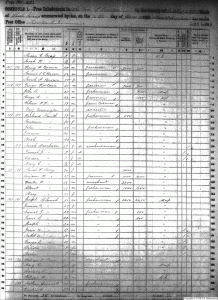
What is interesting to note is that the total population for Tiverton from the 1860 census decreased dramatically to 1,927, a loss of nearly 60% since the last census. What caused this to happen? No pandemic. No war . . . yet. Could it have been gold fever? In 1850, California was admitted into the Union as the 31st state because of its booming population due to the discovery of gold. Within the next few years of the 1850 decade, more western territories were formed: Washington, Oregon, Utah, Arizona, and New Mexico. Could some of the Tiverton families have moved west for more opportunity and land?
The population of Tiverton gradually grew again over the next two decades: 1865-1,973, 1870-1,898, 1875-2,101, 1880-2,505.
The 1880 census was the first to identify an individual’s relation to the head of household. In addition, the 1880 census was the first to identify the state, county, and other subdivisions; the name of the street and house number for urban households; illness or disability at the time the census was taken; marital status; number of months unemployed during the year; and the state or country of birth of every individual’s father and mother. It is the only U. S. census available for the last two decades of the 1800s. Most of the original 1890 population schedules were destroyed in a fire at the Commerce Department in 1921.
According to Bayles’ History of Newport County Rhode Island, in 1885, Tiverton contained less than one percent of the population of the state: 2,702. This was further detailed as: 1,342 white men, 1,348 white women, 4 black men, 8 black women. Of the white totals, 1,031 white men were designated “Native,” with 991 white women listed as “Native.” There were 311 “foreign” men and 357 “foreign” women. There are no “mulattoes” [sic] or Indians listed in Tiverton for 1885.
The 1920 Census was begun on 1 January 1920. The actual date of the enumeration appears on the heading of each page of the census schedule, but all responses were to reflect the individual’s status as of 1 January, even if the status had changed between 1 January and the day of enumeration. For example, children born between 1 January and the day of enumeration were not to be listed, while individuals alive on 1 January but deceased when the enumerator arrived were to be counted.
The following questions were asked by enumerators:
• Name of street, avenue road, etc.
• House number or farm
• Number of dwelling in order of visitation
• Number of family in order of visitation
• Name of each person whose place of abode was with the family
• Relationship of person enumerated to the head of the family
• Whether home owned or rented; if owned, whether free or mortgaged
• Sex
• Color or race
• Age at last birthday
• Whether single, married, widowed, or divorced
• Year of immigration to United States
• Whether naturalized or alien
• If naturalized, year of naturalization
• Whether attended school any time since 1 September 1919
• Whether able to read
• Whether able to write
• Person’s place of birth
• Mother tongue
• Father’s place of birth
• Father’s mother tongue
• Mother’s place of birth
• Mother’s mother tongue
• Whether able to speak English
• Trade, profession, or particular kind of work done
• Industry, business, or establishment in which at work
• Whether employer, salary or wage worker, or working on own account
• Number of farm schedule
Due to boundary modifications in Europe resulting from World War I, some individuals were uncertain about how to identify their national origin. Enumerators were instructed to spell out the name of the city, state, province, or region of respondents who declared that they or their parents had been born in Germany, Austria-Hungary, Russia, or Turkey. Interpretation of the birthplace varied from one enumerator to another. Some failed to identify specific birthplaces within those named countries, and others provided an exact birthplace in countries not designated in the instructions.
There are no separate Indian population schedules in the 1920 census. Inhabitants of reservations were enumerated in the general population schedules. Enumerators were instructed not to report servicemen in the family enumerations but to treat them as residents of their duty posts. The 1920 census includes schedules for overseas military and naval forces.
In light of this, the Tiverton census sheets became more detailed, with population information obtained from each village or district within the Township: Stone Bridge Village, Tiverton Village, Tiverton 4 Corners Village, and Crandall Road District. Sample pages from each are shown below. (The entire census sheets are available at www.usgwarchives.net/ri/newport/census/1920/ if you want to delve into all the names and figures for each household.)
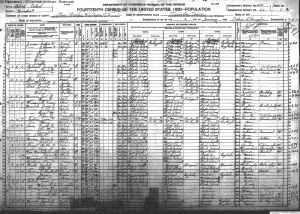
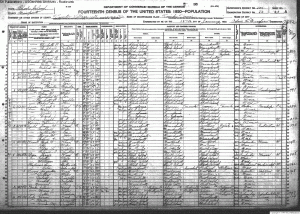
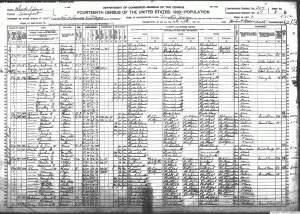
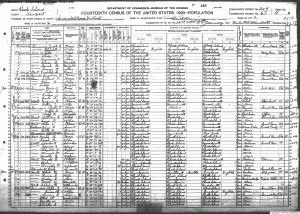
The United States Census has come a long way since these early ones. It is now online for those who have access to the internet. There are also a lot less questions and details than what was covered in some of these earlier censuses! This year is the 2020 Census. If you haven’t completed yours, do so now at 2020census.gov. Your State Representatives in the House of Representatives depend on it!
[Note: Quotes and early history from Bayles’ History of Newport County Rhode Island, 1888. Information regarding each census is from https://rhodeislandgenealogy.com/census.
Tiverton population numbers for 1800’s including 1885, thanks to Jason Eckhardt, Tiverton Public Library reference librarian.]
